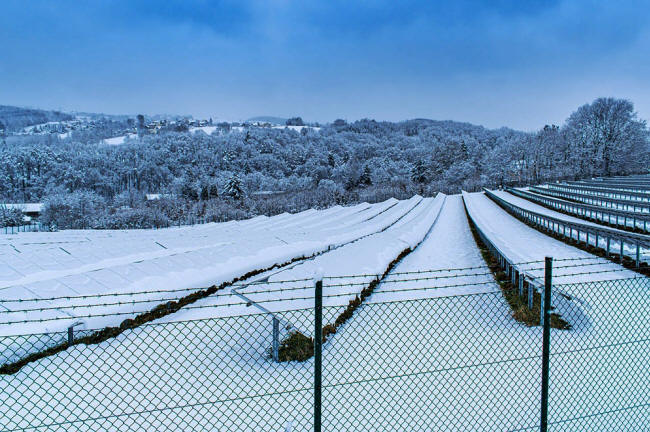|
by Hannes Sarv from Freedom-Research Website
You might also call it common sense, but there is not much use of solar panels if they are under the snow. Photo: Cornell Frühauf/Pixabay.
explains that instead of CO2, it is the Sun that drives the climate change and because of its decreasing activity we should be ready for a colder period...
On the contrary, she points out, every garden centre uses it in its greenhouses to make plants lush and green.
...adding that the proportion of CO2 in the atmosphere has been at much higher levels throughout our planet's history than it is now.
In fact, over the last 140 million years, the amount of CO2 in the atmosphere has been steadily decreasing and only now slightly starting to rise.
140 million years ago, it was estimated at 2,500 ppm (0.25%), or about six times higher. And it also meant a greener and more biodiverse world.
Zharkova says that the fact that CO2 levels in the atmosphere are now increasing is a good thing...!
The Sun - A Natural Driver of Climate ChangeIn fact, Professor Zharkova can go on at length about what CO2 does or does not do in nature and how it behaves, but she does not actually study it directly as a scientist.
Professor Zharkova says that our climate changes occur because of the Sun. Photo: by courtesy of Prof. Zharkova.
Zharkova is an astrophysicist originally from Ukraine.
However, her research has focused on the Sun and she can confirm that,
So much so, in fact, that Zharkova's research suggests that we have entered a colder period, or essentially a little ice age, in the next 30 years, as the sun's activity weakens in the context of global warming.
In other words, there is not a question of Zharkova - or any other scientist who is justifiably skeptical about the omnipotent power of the CO2 molecule to warm the air - denying climate change.
On the contrary,
For example, Zharkova points out that in Scotland, where she has lived for many years, the weather was much warmer 2,000 years ago.
However,
This is a huge change...
Zharkova estimates using some previous research that on average - which of course means much larger changes from region to region - the Earth's temperature will fall by 1 degree Celsius over the next 30 years, and not rise, as the UN's Intergovernmental Panel on Climate Change (IPCC) warns us.
She explains that such abrupt changes depend on the cycles of solar activity.
According to Zharkova, such a change occurs every 350-400 years (grand solar cycle or GSC), and she says we entered one of the Grand Solar Minima (GSM) separating GSCs in 2020.
This GSM will continue until 2053 after which in cycle 28 the solar activity will return to normal.
Would not recommend a Solar Panel InvestmentSo for the foreseeable future, according to Zharkova, we should not be thinking in terms of global warming, but of a significant cooling, such as that occurred in the 17th century, which will, of course, have a direct impact on our way of life.
Take energy, for example, where, under the banner of the 'green transition' and move to 'Net Zero', the aim is to replace today's energy production capacity with renewables, solar panels, for example, as we move away from fossil fuels.
According to Zharkova, in times of declining solar intensity, it is not worth naively hoping that solar panels will be able to produce any significant amount of energy.
When you consider that in the low period of solar activity, we can expect winters to get longer and that in northern Europe it may even snow in June, as it did in the 17th century, the prospects for solar panels are not very good.
We can also expect colder weather to put wind power generation under pressure - there are plenty of examples of wind turbines freezing and stalling.
This means that better conditions for food production will have to be sought in southern Europe or even in Africa. In the north, more energy is needed to produce food, to heat homes, and for all other activities.
According to Zharkova, there is no getting away from fossil fuels now, which are a reliable source of energy, under such conditions.
Global Warming is also a RealityBut Zharkova says a cold period of a few decades is a short episode compared to the current long warming trend.
Again, there is nothing unexpected about a change in the position of the planets and the Sun in space, relative to us.
This too has happened repeatedly over a long history. It happens because of the gravitational pull of the big planets, and as the Sun moves closer to Earth, it raises the air temperature here.
According to Zharkova, this solar cycle lasts for 2,100-2300 years and it is known as Hallstatt's cycle of solar radiation changes measured in the Holocene by many researchers from the isotope C14 abundances in the terrestrial biomass.
The current cycle will come to an end at around the year 2600, and although there will be another low period of solar activity, or GSM (2375-2415) during this period when it will be colder again, there will be a steady warming over the following five centuries.
Based on her calculations, Zharkova estimates a temperature rise of 3.5º C by 2600.
According to Zharkova, in the overall context of the CO2 climate change narrative, it is important to understand that humans are actually bystanders in this process of change.
"Like the Spanish Inquisition"However, it is precisely the fact that this process is natural that the mainstream climate science currently denies, and the only acceptable cause of climate change is the increase in the proportion of "anthropogenic" CO2 in the atmosphere.
According to Zharkova, one does not bother with such "little things" as the Sun.
In fact, she points out, that it has also been scientifically shown that the increase in atmospheric CO2 does follow the increase in temperature, and not the other way round, but this is another point that the proponents of "anthropogenic" climate warming refuse to take into account.
Zharkova herself has experienced such attempts of silencing and persecution.
She cites the example of a recent retraction in March 2020 of one of her scientific articles (Oscillations of the baseline of solar magnetic field and solar irradiance on a millennial timescale - Zharkova et al, 2019) by the Editor Rafal Marszalek of the Nature Scientific Reports under pressure from the proponents of anthropogenic global warming, as she had mentioned in the article that,
Since you can logically argue that this could also affect the Earth's climate, the paper had to be retracted.
She is no longer welcome to publish in Nature, although she has done so several times in the past.
This retraction is the case, she says, for anyone who questions man-made global warming and explains climate change in any other way.
...Zharkova says about the proponents of anthropogenic global warming, with her characteristic humor, and jokingly refers to them as the CO2 mafia...
A year later after the retraction in April 2021, Zharkova published a book chapter proving with the official ephemeris of the Sun-Earth distances provided by the official sides of NASA and Paris-Meudon Observatory, France that these Sun-Earth distances change exactly as they mentioned in the retracted paper.
She says it proves that the Sun, its activity, and its position in the orbit are the natural source of any climate change on Earth and other planets...
|



